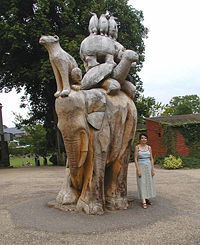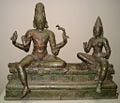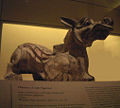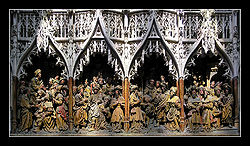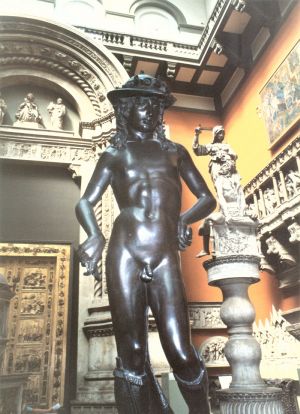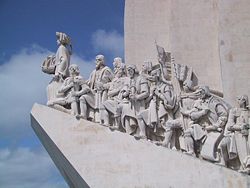Difference between revisions of "Sculpture" - New World Encyclopedia
m (→Europe) |
|||
| Line 5: | Line 5: | ||
A '''sculpture''' is a three-dimensional, human-made object selected for special recognition as art. Every culture since the beginning of man has sculpted objects that have lasted hundreds or even thousands of years, | A '''sculpture''' is a three-dimensional, human-made object selected for special recognition as art. Every culture since the beginning of man has sculpted objects that have lasted hundreds or even thousands of years, | ||
| − | + | ==''' History of Sculpture''' == | |
| − | |||
The history of sculpture could be said to be akin to the materials used and as man progressed, so did the tools and materials that he utilised. So we find objects from distant civilisations created out of crude clay or stone, something that could be chipped away at with primitive tools. With the invention of fire came pottery and other three-dimensional objects, perhaps of worship, etc. Later on we see iron and other metals, precious or otherwise, being forged into shapes and in the Greek period, for instance very sophisticated carvings of the human form, that even the Renaissance artists envied and tried to emulate. | The history of sculpture could be said to be akin to the materials used and as man progressed, so did the tools and materials that he utilised. So we find objects from distant civilisations created out of crude clay or stone, something that could be chipped away at with primitive tools. With the invention of fire came pottery and other three-dimensional objects, perhaps of worship, etc. Later on we see iron and other metals, precious or otherwise, being forged into shapes and in the Greek period, for instance very sophisticated carvings of the human form, that even the Renaissance artists envied and tried to emulate. | ||
So, as materials evolved so did sensibilities, so that giant Bhuddas, or mythological creatures, for instance, were created to raise feelings of awe whilst the Mannerists after the Rennaissance elongated forms that we might understand that humans were more than mere flesh and blood. After periods of strict realism came the romantics and then the moderns who wanted to get back to basics with abstract form and even the use of everyday objects. | So, as materials evolved so did sensibilities, so that giant Bhuddas, or mythological creatures, for instance, were created to raise feelings of awe whilst the Mannerists after the Rennaissance elongated forms that we might understand that humans were more than mere flesh and blood. After periods of strict realism came the romantics and then the moderns who wanted to get back to basics with abstract form and even the use of everyday objects. | ||
Today anything conceived of is almost possible thru the swift advance of the sciences and technology. | Today anything conceived of is almost possible thru the swift advance of the sciences and technology. | ||
| − | |||
| − | |||
| − | |||
| − | |||
| − | |||
== '''Sculpture Materials'''== | == '''Sculpture Materials'''== | ||
| Line 38: | Line 32: | ||
In his late writings, [[Joan Miró]] even proposed that some day sculptures might be made of gases.[http://www.answers.com/topic/gas-sculpture] | In his late writings, [[Joan Miró]] even proposed that some day sculptures might be made of gases.[http://www.answers.com/topic/gas-sculpture] | ||
| − | ==Sculpture around the world== | + | =='''Sculpture around the world'''== |
==='''Asian'''=== | ==='''Asian'''=== | ||
:See also ''[[Buddhist art]]'' | :See also ''[[Buddhist art]]'' | ||
| Line 110: | Line 104: | ||
===Europe=== | ===Europe=== | ||
| − | '''An overview of forms''' | + | ''' |
| + | == An overview of forms == | ||
| + | ''' | ||
[[Image:P3280004.JPG|Right|thumb|200px|''The Emperor [[Tiberius]]'' enameled [[terracotta]] [[bust]] at the [[Victoria and Albert Museum]], 19th century.]] | [[Image:P3280004.JPG|Right|thumb|200px|''The Emperor [[Tiberius]]'' enameled [[terracotta]] [[bust]] at the [[Victoria and Albert Museum]], 19th century.]] | ||
Revision as of 05:32, 18 September 2006
- Sculptor redirects here. For the constellation, see Sculptor (constellation).
A sculpture is a three-dimensional, human-made object selected for special recognition as art. Every culture since the beginning of man has sculpted objects that have lasted hundreds or even thousands of years,
History of Sculpture
The history of sculpture could be said to be akin to the materials used and as man progressed, so did the tools and materials that he utilised. So we find objects from distant civilisations created out of crude clay or stone, something that could be chipped away at with primitive tools. With the invention of fire came pottery and other three-dimensional objects, perhaps of worship, etc. Later on we see iron and other metals, precious or otherwise, being forged into shapes and in the Greek period, for instance very sophisticated carvings of the human form, that even the Renaissance artists envied and tried to emulate. So, as materials evolved so did sensibilities, so that giant Bhuddas, or mythological creatures, for instance, were created to raise feelings of awe whilst the Mannerists after the Rennaissance elongated forms that we might understand that humans were more than mere flesh and blood. After periods of strict realism came the romantics and then the moderns who wanted to get back to basics with abstract form and even the use of everyday objects. Today anything conceived of is almost possible thru the swift advance of the sciences and technology.
Sculpture Materials
The historic materials for sculpture
Throughout human history sculptures have been created that became objects of art with a permanence unlike other art. Works have been produced in durable and frequently expensive materials, primarily; bronze and stone such as marble, limestone, porphyry, and granite. Less frequently precious materials such as gold, silver, jade, and ivory were usually used for chryselephantine works.
Common materials used for sculpture that made for wider consumption included materials like woods such as oak, box and lime, ceramics like terracotta, and cast metals such as pewter and spelter.
Sculptors often build small preliminary works called maquettes of ephemeral materials such as plaster of Paris, wax, clay and even plasticine. Henry Moore's enormous pieces usually started out as small plaster or plasticine maquettes.
Contemporary materials
Most traditional sculpture materials are still in wide use today, but advancements in technology have broadened the range of materials sculptors have at hand. Materials now include glass and sand, aluminum, polymers and many synthetic materials like liquid crystals.
In today's film and theater industries it is common for sculptors to carve large statuary from blocks of polystyrene. Although not durable, it is light and can be cut easily with a hot wire.
Some sculptures are multimedia in that they have form and produce sound. Many artists use video and/or computers in their sculptures as well. Computers and motors can be used in sculptures, leading to works that may be classified as robotic. Some sculptors are using 3D modeling software and rapid prototyping systems to realize form in plastic polymers. Sculptors are also using CNC mills to mill out stone and clay in creating works that can be visualized virtually and manifested physically.
Sculptors are constantly searching for new ways to make art with new materials. Blood, dead animals, and body fluids are some of the more unusual choices fo modern sculptors. Andy Goldsworthy is notable as a sculptor for his use of almost entirely natural materials in natural settings and for creating sculpture more ephemeral than is typical. Jim Gary used automobile parts, tools, machine parts, and hardware in many of his sculptures as well as stained glass. Pablo Picasso used bicycle handlebars as bulls' horns. Marcel Duchamp used a bicycle wheel impaled on a bar stool as one of his ready-made (found) objects.
In his late writings, Joan Miró even proposed that some day sculptures might be made of gases.[1]
Sculpture around the world
Asian
- See also Buddhist art
Many different forms of sculpture were in use in many different regions of Asia, often based in the religions of Hinduism and Buddhism. A great deal of Cambodian Hindu sculpture is preserved at Angkor, however organized looting destroyed many sites around the country. Also see Angkor Wat. In Thailand, sculpture was exclusively of Buddha images. Many Thai sculptures or temples are gilded, and on occasion enriched with inlays. See also Thai art
India
- See also Indian Art
The first sculptures in India date back to the Indus Valley civilization, where stone and bronze carvings have been discovered. Here is one of the earliest instances of sculpture in the world. Later, as Hinduism, Buddhism and Jainism developed further, India produced some of the most intricate bronzes in the world, as well as unrivaled temple carvings. Some huge shrines, as the one at Ellora were carved out of solid rock, making them the largest and most intricate sculptures in the world.
During the 2nd to 1st century B.C.E. in far northern India, in what is now southern Afghanistan and northern Pakistan, sculptures included episodes of the Buddha’s life and teachings. Although India had a long sculptural tradition, the Buddha was never represented in human form before this time, but only through his symbols. This may be because Gandharan Buddhist sculpture in modern Afghanistan displays Greek and Persian artistic influence. Artistically, the Gandharan school have contributed wavy hair, drapery on both shoulders, shoes and sandals, acanthus leaf decorations, etc.
The pink sandstone sculptures of Mathura evolved during the Gupta period (4th to 6th century) to reach finesse of execution and delicacy in the modeling. Newer sculptures in Afghanistan, in stucco, or clay, display very strong blending of Indian post-Gupta mannerism, with Hellenistic or even Greco-Roman, influences. Meanwhile, elsewhere in India, less anatomically accurate styles of human representation evolved,leading to the classical style that the world is now familiar with and contributing to Buddhist and Hindu sculpture throughout Asia.
China
- See also Chinese art
Chinese artifacts date back as early as 10,000 B.C.E. whilst skilled,Chinese artisans have been active up to the present time. However, the bulk of sculpture displayed in European museums come from only a few, historical periods. The first period of interest is the Zhou Dynasty (1050-771 B.C.E.), from which comes a variety of intricate cast bronze vessels. The next period of interest is the Han Dynasty ( 206 B.C.E. - 220 C.E.) — beginning with the spectacular Terracotta, army. This was assembled for the tomb of the first Emperor of the brief Chin dynasty that preceded it. (Qin Shi Huang) in 210–209 B.C.E.) Tombs excavated from the Han period have revealed many figures that are, vigorous, direct, and appealing, 2000 years later.
The period considered to be China's golden age is the Tang Dynasty. (This coincides with what in Europe is sometimes called "The Dark Ages"). Decorative figures like those shown below became very popular in 20th Century Euro-American culture. They were made available in bulk, as warlords in the Chinese civil wars exported them to raise cash. Considered especially desirable, and profound, was the Buddhist sculpture. Many of these, often monumental and begun in the Sui Dynasty, inspired by the Indian art of the Gupta period, are considered treasures of the art world.
Following the Tang, Western interest in Chinese artifacts declines dramatically, except for ornamental furnishings and especially objects in jade. Pottery from the Tang period stands out for its free and easy feeling. Chinese sculpture has no nudes —other than figures made for medical training or practice — and little portraiture compares with the European tradition. One place where sculptural portraiture was pursued, was in the monasteries.
Almost nothing, other than jewelry, jade, or pottery is collected by art museums after the Ming Dynasty ended in the late 17th century — and absolutely nothing has yet been recognized as sculpture from the tumultuous 20th century. However, there were schools of Soviet-influenced social realist sculpture early in the the Communist regime but as the century turned, Chinese craftsmen began to dominate commercial genres (collector plates, figurines, toys, etc) whilst avant garde Chinese artists participated in the Euro-American enterprise of contemporary art.
Wine jar, Zhou Dynasty
Chimera (from a tomb) , Han Dynasty
tomb figure, Han Dynasty
Boddisatva, Tang Dynasty
Jade chalice, Ming Dynasty
- AIC-lushanjar.jpg
Jar from Lushan, Tang Dynasty
Japan
- See also Japanese art, Japanese sculpture
Under governmental sponsorship, countless paintings and sculpture were often made. Most Japanese sculpture is associated with religion, and it's use declined with the lessening importance of traditional Buddhism. During the Kofun period of the third century, clay sculptures called haniwa were erected outside tombs. Inside the Kondo at Horyu-ji is a Shaka Trinity (623), the historical Buddha flanked by two bodhisattvas and also the Guardian Kings of the Four Directions The wooden image ( 9th c.) of Shakyamuni, the "historic" Buddha, enshrined in a secondary building at the Muro-ji, is typical of the early Heian sculpture. It has a ponderous body, covered by thick drapery folds carved in the hompa-shiki (rolling-wave) style, and an austere, withdrawn facial expression. The Kei school of sculptors, particularly Unkei, created a new, more realistic style of sculpture.
Africa
- See also African art
African art has an emphasis on Sculpture - African artists tend to favor three-dimensional artworks over two-dimensional works. The earliest known sculptures are from the Nok culture of Nigeria, made around 500 B.C.E. Probably the most famously portrayed are the "shrunken heads of enemies"!
Egypt
- See also Art of ancient Egypt
The ancient art of Egyptian sculpture evolved to represent the ancient Egyptian gods, along with the Pharaohs, divine kings and queens, in physical form. Very strict conventions were followed whilst crafting statues: male statues were darker than the female ones; in seated statues, hands were required to be placed on knees, specific rules governed the appearance of every Egyptian god. Artistic works were ranked according to exact compliance with all the conventions, and the conventions were followed so strictly that over three thousand years, very little changed in the appearance of their statutes.
United States
See also: Sculpture of the United States
The history of sculpture in the United States reflects the nation's 18th century foundation in Roman republican civic values as well as Protestant Christianity. American sculpture of the mid to late 19th century was often classical, often romantic, but showed a special bent for a dramatic, narrative, almost journalistic realism. Public buildings of the first half of the 20th century often provided an architectural setting for sculpture, especially in relief. In the 1950s traditional sculpture would almost be completely replaced by a Bauhaus (ie. Marxist) influenced concern for abstract design. Minimalist sculpture often replaced the figure in public settings. Modern sculptors use both classical and abstract inspired designs. Beginning in the 1980s there was a retro-active swing back towards figurative public sculpture and by the year 2000 many of the new public pieces in the United States were figurative in design.
Europe
An overview of forms
Some common forms of sculpture are:
- The bust, a representation of a person from the chest (torso) up.
- Equestrian sculpture, typically showing a significant person on horseback.
- Free-standing sculpture, sculpture that is surrounded on all sides, except the base, by space. it is also known as sculpture "in the round."
- Fountain, in which the sculpture is designed with moving water.
- "In the round": designed by the sculptor to be viewed from any angle.
- Jewelery
- Mobile (See also Calder's Stabiles.)
- Relief: sculpture still attached to a background, standing out from that ground in "High Relief" or "Low Relief" (bas relief)
- Site-Specific Art
- Statue
Perhaps the majority of public art is sculpture. See also sculpture garden.
Greek-Roman-classical
- See also Sculpture of Ancient Greece
Features unique to the European Classical tradition:
- full figures: using the young, athletic male or full-bodied female nude
- portraits: showing signs of age and strong character
- use of classical costume and attributes of classical deities
- Concern for naturalism based on observation, often from live models.
Features that the European Classical tradition shares with many others:
- characters present an attitude of distance and inner contentment
- details do not disrupt a sense of rhythm between solid volumes and the spaces that surround them
- pieces feel solid and larger than they really are
- ambient space feels sacred or timeless
The topic of Nudity
A Nude or 'unadorned' figure in Greek classical sculpture was a reference to the status or role of the depicted person, deity or other being. Athletes, priestesses and gods could be identified by their adornment or lack of it.
The Renaissance preoccupation with Greek classical imagery, such as the 4th century B.C.E. Doryphoros of Polykleitos, led to nude figurative statues being seen as the 'perfect form' of representation for the human body. Subsequently, nudity in sculpture and painting has represented a form of ideal, be it innocence, openness or purity. Nude sculptures are still common. As in painting, they are often made as exercises in efforts to understand the anatomical structure of the human body and develop skills that will provide a foundation for making clothed figurative work.
Nude statues are usually widely accepted by most societies, largely due to the length of tradition that supports this form. Occasionally, the nude form draws objections, often by fundamentalist moral or religious groups. Classic examples of this are the removal of penises from the Vatican collection of Greek sculpture and the addition of a fig leaf to a plaster cast of Michelangelo's sculpture of David for Queen Victoria's visit to the British Museum.
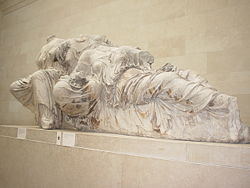
The topic of social status
Worldwide, sculptors are usually tradesmen whose work is unsigned. But in the Classical tradition, some sculptors began to receive individual recognition in Periclean Athens and more so in the Renaissance revival 2000 years later. This, culminating in the career of Michelangelo who entered the circle of princes, under the Medici. Sculpture was still a trade, but exceptional sculptors were recognized on a level with exceptional poets and painters. In the 19th century, sculpture also became a bourgeois/upper class avocation, as poetry and painting had been, and the classical work of women sculptors began to appear. However, some suffered discrimination as was Claudia Claudel, a student under Rodin but recognized as an original in her own right, only to be persecuted by him until she finally ended up in the madhouse and was soon forgotten.
Gothic
Gothic sculpture evolved from the early stiff and elongated style, partly Romanesque, into a spatial and naturalistic feel in the late 12th and early 13th century. The architectural statues at the Western (Royal) Portal at Chartres Cathedral (ca. 1145) are the earliest Gothic sculptures and were a revolution in style and the model for a new generation of sculptors. Prior to this there had been no sculpture tradition in Ile-de-France—so sculptors were brought in from Burgundy. The Bamberg Cathedral had the largest assemblage of 13th century sculpture. In England sculpture was more confined to tombs and non-figurine decorations. In Italy there was still a Classical influence, but Gothic made inroads in the sculptures of pulpits such as the Pisa Baptistery pulpit (1269) and the Siena pulpit. Dutch-Burgundian sculptor Claus Sluter and the taste for naturalism signaled the end of Gothic sculpture, evolving into the classicist Renaissance style by the end of the 15th century.
Renaissance
- See also Renaissance
Sculpture was also revived, in many cases before the other arts. There was a very obvious naturalism and highly true to life figures were being sculpted. One of the most important sculptors in the classical revival was Donatello. His greatest achievement of his classic period is the bronze David (not to be confused with Michelangelo's ), which is currently located at the Bargello in Florence. At the time of its creation, it was the first free-standing nude statue since ancient times. Conceived fully in the round and independent of any architectural surroundings, it was the first major work of Renaissance sculpture.
Among the many sculptures of Michelangelo are those of David and the Pietà, as well as the Doni Virgin, Bacchus, Moses, Rachel, Leah, and members of the Medici family. Michelangelo's David is possibly the most famous sculpture in the world, which was unveiled on September 8, 1504. It is an example of the contrapposto style of posing the human figure. Michelangelo's statue of David differs from previous representations of the subject in that David is depicted before his battle with Goliath and not after the giant's defeat. Instead of being shown victorious over a foe much larger than he, David looks tense and ready for combat.
Mannerist
Benvenuto Cellini created a salt cellar of gold and ebony in 1540 featuring Neptune and Amphitrite (earth and water) in elongated form and uncomfortable positions. It is considered a masterpiece of Mannerist sculpture.This idealism was to portray humans as not only physical but spiritual beings, hence the elongated forms that seemed to make them more than who they were.
Baroque
In Baroque sculpture, groups of figures assumed new importance, and there was a dynamic movement and energy of human forms— they spiraled around a central vortex, or reached outwards into the surrounding space. For the first time, Baroque sculpture often had multiple viewing angles. The characteristic Baroque sculpture added extra-sculptural elements, concealed lighting, or water fountains. Bernini was undoubtedly the most important sculptor of the Baroque period. His first works were inspired by Hellenistic sculpture of ancient Greece and imperial Rome. One of his most famous works is Ecstasy of St Theresa
Neo-Classical
This movement embraced mostly Roman copies of Hellenistic sculptures. In sculpture, the most familiar representatives are the Italian Antonio Canova, the Englishman John Flaxman and the Dane Bertel Thorvaldsen.
Modernism
Modern Classicism contrasted in many ways with the classical sculpture of the 19th Century which was was characterized by commitments to naturalism (Antoine-Louis Barye) — the melodramatic (François Rude) sentimentality (Jean Baptiste Carpeaux)— or a kind of stately grandiosity (Lord Leighton) Several different directions in the classical tradition were taken as the century turned, but the study of the live model and the post-Renaissance tradition was still fundamental to them.
Auguste Rodin was the most renowned European sculptor of the early 20th century. He might be considered as sui generis — that is, if anyone successfully composed in his turbulent, virtuosic style, they have yet to be discovered. He is often considered a sculptural Impressionist, like Medardo Rosso, Count Troubetski, and Rik Wouters, attempting to frame the charm of a fleeting moment of daily life.
Modern Classicism showed a lesser interest in naturalism and a greater interest in formal stylization. Greater attention was paid to the rhythms of volumes and spaces - as well as greater attention to the contrasting qualities of surface (open, closed, planar, broken etc) while less attention was paid to story-telling and convincing details of anatomy or costume. Greater attention was given to psychological realism than to physical realism. Greater attention was given to showing what was lasting and public, rather than what was momentary and private. Greater attention was given to examples of ancient and Medieval sacred arts: Egyptian, Middle Eastern, Asian, African, and Meso-American. This may well have been a result of the new materialistic societies and belief in logic & reason rather than spirituality.
Early masters of modern classicism included: Aristide Maillol, Alexander Matveev, Joseph Bernard, Antoine Bourdelle, Georg Kolbe, Libero Andreotti, Gustav Vigeland, Jan Stursa
As the century progressed, modern classicism was adopted as the national style of the two great European totalitarian empires: Nazi Germany and Soviet Russia, who co-opted the work of early masters, like Kolbe and Arno Breker in Germany, and Matveev in Russia. Nazi Germany only 15 years but over the 70 years of Communism, especially in the USSR, new generations of sculptors were trained and a distinct style, socialist realism, developed, that returned to the 19th century's emphasis on melodrama and naturalism.
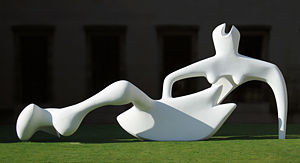
In the rest of Europe, the modern classical became either more decorative/art deco (Paul Manship, Carl Milles) or more abstractly stylized (Henry Moore, Alberto Giacometti,Julio González (sculptor)) or more expressive (and Gothic) (Anton Hanak, Wilhelm Lehmbruck, Ernst Barlach, Arturo Martini) — or turned more to the Renaissance (Giacomo Manzu, Venanzo Crocetti) or stayed the same (Charles Despiau, Marcel Gimond).
Classical training was rooted out of art education in Western Europe (and the Americas) by 1970 and the classical variants of the 20th Century were marginalized in the history of modernism. But classicism continued as the foundation of art education in the Soviet academies until 1990, providing a foundation for expressive figurative art throughout eastern Europe and parts of the Middle East.
By the year 2000, the European classical tradition maintains a wide appeal to viewers -especially tourists - and especially for the ancient, Renaissance, Baroque, and 19th century periods — but awaits an educational tradition to revive its contemporary development. Some would say that in the new millennium the return to the figurative tradition has begun in ernest.
Modernist movements included Cubism, Futurism, Minimalism, Installation art and Pop-Art.
Post-modernism
Contemporary Sculpture genres
Some modern sculptural forms are now conceived outdoors, and often in full view of spectators, thus giving them kinship to performance art in the eyes of some. Ice sculpture is a form that uses ice as raw material. Popular in China, Japan, Canada, Sweden and Russia, Ice sculptures feature decoratively in some cuisines, especially in Asia. Kinetic sculptures are sculptures that are designed to move, which include Mobiles. Snow sculptures are usually carved out of a single block of snow about 6 to 15 feet on each side and weighing about 20 - 30 tons. The snow is densely packed after being produced artificially or collected after a snowfall. Sound sculptures take the form of indoor or outdoor sound installations, with aeolian harps, automatons, or be more conventional musical instruments. Sound sculpture is often site-specific. A Sand castle can be regarded as a sand sculpture.
Other arts which can be regarded as sculptures include:
Greenfield Products Pty Ltd v. Rover-Scott Bonnar Ltd
The Australian copyright case of Greenfield Products Pty Ltd v. Rover-Scott Bonnar Ltd (1990) 17 IPR 417 is authority for the proposition that for copyright or intellectual property rights purposes, a thing not intended to be a sculpture is not a sculpture. In this case the judge stated:
- It appears to me clear that neither the molds nor the drive mechanism, nor the parts of the latter, are sculptures in the ordinary sense. It is true, as was pointed out in the course of argument, that some modern sculptures consist of or include parts of machines, but that does not warrant the conclusion that all machines and parts thereof are properly called sculptures, and similar reasoning applies to molds.
Though this seems contrary to some famous examples of sculpture, including Marcel Duchamp's 1917 sculpture consisting of a porcelain urinal lying on its back, titled Fountain, and Carl Andre's sculpture Equivalent III exhibited in the Tate Gallery in 1978, consisting of bricks stacked in a rectangle, this is not really the case since Duchamp and others were intending to produce works of art as opposed to the litigants in the lawsuit who were intending to produce riding lawn mowers.
http://www.austlii.edu.au/au/cases/cth/federal_ct/unrep4166.html
See also
See the category Sculpture for full listing of sculpture topics.
- History of sculpture
- Selected sculptures
- Sculpture basic topics
External links
- Offbeat Sculptures
- Cass Sculpture Foundation - British contemporary sculpture
- Sculpture in the Sistine Chapel? What for?
Credits
New World Encyclopedia writers and editors rewrote and completed the Wikipedia article in accordance with New World Encyclopedia standards. This article abides by terms of the Creative Commons CC-by-sa 3.0 License (CC-by-sa), which may be used and disseminated with proper attribution. Credit is due under the terms of this license that can reference both the New World Encyclopedia contributors and the selfless volunteer contributors of the Wikimedia Foundation. To cite this article click here for a list of acceptable citing formats.The history of earlier contributions by wikipedians is accessible to researchers here:
The history of this article since it was imported to New World Encyclopedia:
Note: Some restrictions may apply to use of individual images which are separately licensed.
